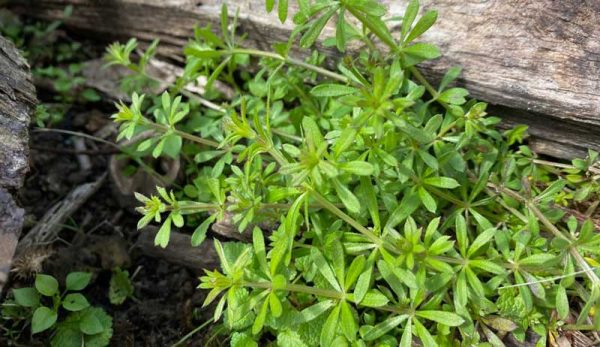
Cleavers (Galium aparine) and many other traveling seed bearers may be lumped into the common name “stick-tights.” I am pretty sure I didn’t have them at my home until my dogs brought them home on their fur. Before I recognized these tiny seeds as cleavers, even as they were accumulating in hairy mats, they seemed friendly to me compared to other “stick-tights” (like burdock or cocklebur), whose barbs would painfully stab the skin of a dog or my fingers extracting them.
I think of a cleavers as a friendly hitchhiker. I have heard kids refer to them as “velcro plant” because you can throw a stalk at someone and it will cling to almost any clothing on contact.
Identifying Cleavers
With leaves resembling a bottle brush, their stiffness gives them away, as does as their shape. Identifying cleavers’ growth pattern is rewarding, as its habits are very uniform and consistent. Early leaves have the same form as later leaves, just smaller and shorter.
In spring, the plant’s green color is consistent down to its minimal and pale roots. Older plants can grow to over 3 feet high if they have something to lean on, which could be as simple as a nearby stalk of grass or a forb. Cleavers are less trellising climbers and more “neighbor-clingers.”
Also Read: Gather Cleavers for Springtime Medicine
But they may also simply crawl along the ground. They are also known as “bed straw” as the plant’s more fragrant cousins were used as bedstuff. When they form large clumps and begin to lay across the ground, cleavers do seem to me a perfect bedding.

The Benefits of Cleavers
Cleavers are somewhat “brushy” when you touch them, kind of like a scratchy sponge or cat tongue—not scratchy enough to hurt, just hard enough to comb and scrub.
This quality seems to determine cleavers’ benefit to our lymphatic system. The body works hard to clean itself, and the lymphatic system has a huge hand in that. We can imagine cleavers as a bottle brush to our internal fluid pumps, helping us scrub out things left behind from the hard work the body does to protect and repair.
Cleavers are perfect for spring, as we emerge from slow winter activities (and resulting slowed digestion) and want to wash out the seasonal sluggishness. Cleavers may help us get moving with lubricated joints and systems in full pump.
Also Read: Forage wild garlic (or onion grass) for flavorful goodness.
Preparing Cleavers
I learned the best way to use cleavers is to gather them fresh, then pack as many as you can into as tight a jar as possible. Cover it in some good water, stick it in the fridge overnight, and drink the whole thing the next day.
I typically prepare a gallon of tightly packed fresh plant, but you can use whatever quantity you gather.
But be sure to also drink as close to a gallon of water as you can that same (or next) day after your cleavers preparation is gone. This will contribute to the flushing action, “forcing” the cleavers infusion to more fully saturate your system. You can do this any time you feel sluggish, such as after a long illness, or as routine maintenance.
You can also try to make a “succus” by juicing the leaves. But good luck finding a blender that will chop them! I find they just spin around making wreaths, even in my spice grinder, whether fresh or dried.
Dried cleavers are rumored to be less potent. Plenty of people make a tincture out of cleavers or use the dried leaves for tea, but either use calls for a long, cold infusion. And a tincture of fresh cleavers will be preferable to dried, using more water than alcohol. Just about 25 percent alcohol is enough to preserve, allowing more water-soluble components to get into your preparation.
Harvesting Cleavers
These plants grow fast. They’re shooting up now in my home state of Kentucky and will be making seeds (and turning yellow) within four to six weeks. So whenever you find them is the time to try cleavers!
Depending on your climate, the year’s first shoots can sow themselves another crop for summer, given the landscape is open enough to allow them. They tend to be abundant in dry, sunny locations, easily intermingling in grasses and other so-called weeds.
The flowers are easy to miss. Tiny and white, they resemble chickweed and nestle in the crannies of stems. Invite this fast grower in any time, harvesting the entire plant up until the flowers turn to seeds. You’ll likely leave plenty behind to resow.
As always, give yourself time to acknowledge cleavers for their actions and abundance. This simple act will go a long way to increasing your ability to internalize health benefits. I am confident that the often overlooked and oversimplified places in our yards, as well as those in our bodies, will be thankful for the attention.




